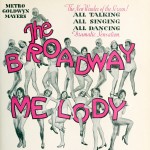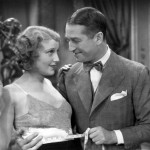 Short sound films were a popular novelty in nickelodeons at the turn of the 20th century. One of the most successful systems was Cameraphone, created in 1907 by James A. Whitman. In the fourth floor studios above Daly’s Theatre, not far from New York’s Tin Pan Alley, Whitman filmed numerous vaudeville stars and then recorded them dubbing their screen performances. Such sound-on-disc separation continued until 1923, when Lee De Forest released the first “soundie” musical short using Phonofilm, a direct sound-on-film system. In 1927, Fox studios introduced the competing Movietone system, which became the industry standard, although Warner released its landmark “talkie” The Jazz Singer in 1927 (and its even more successful followup The Singing Fool in 1928) using the quickly obsolete Vitaphone sound-on-disc system.
Short sound films were a popular novelty in nickelodeons at the turn of the 20th century. One of the most successful systems was Cameraphone, created in 1907 by James A. Whitman. In the fourth floor studios above Daly’s Theatre, not far from New York’s Tin Pan Alley, Whitman filmed numerous vaudeville stars and then recorded them dubbing their screen performances. Such sound-on-disc separation continued until 1923, when Lee De Forest released the first “soundie” musical short using Phonofilm, a direct sound-on-film system. In 1927, Fox studios introduced the competing Movietone system, which became the industry standard, although Warner released its landmark “talkie” The Jazz Singer in 1927 (and its even more successful followup The Singing Fool in 1928) using the quickly obsolete Vitaphone sound-on-disc system.
 Most early screen musicals were adaptations of recent Broadway hits, with some simply being a filmed record of the stage production. As audience demand for sound films grew, studios began devising original stories, but they were anxious that viewers wouldn’t believe characters bursting into song, so the Broadway stage remained a popular setting. In 1929 alone, such backstage stories included Paramount’s Applause, Warner’s Gold Diggers of Broadway, and MGM’s The Broadway Melody (the first “all-talking, all-singing, all-dancing” film), which won the Oscar for Best Picture. With the genre’s growing critical and popular success, film producers grew less anxious.
Most early screen musicals were adaptations of recent Broadway hits, with some simply being a filmed record of the stage production. As audience demand for sound films grew, studios began devising original stories, but they were anxious that viewers wouldn’t believe characters bursting into song, so the Broadway stage remained a popular setting. In 1929 alone, such backstage stories included Paramount’s Applause, Warner’s Gold Diggers of Broadway, and MGM’s The Broadway Melody (the first “all-talking, all-singing, all-dancing” film), which won the Oscar for Best Picture. With the genre’s growing critical and popular success, film producers grew less anxious.
Paramount was one of the first studios to master the genre, with films such as The Love Parade (1929), Love Me Tonight (1932), scored by Rodgers & Hart, and The Big Broadcast (1932). Most other studios, though, offered derivative and hastily made productions, and audiences began to shrink. Hollywood released more than 100 musicals in 1930 but only 14 in 1931. Warner Brothers, which helped create the genre in 1927, helped revive it in 1933 with 42nd Street, specifically with the dances choreographed by Busby Berkeley, who brought Warner continued success with Gold Diggers of 1933, Footlight Parade (1933), and Dames (1934), many scored by Harry Warren and Al Dubin.
As the Depression drove down production budgets, Berkeley’s extravagance gave way to the more streamlined choreography of Fred Astaire and Ginger Rogers, who led RKO’s musical resurgence with films such as Top Hat (1935), scored by Irving Berlin, and Swing Time (1936), scored by Jerome Kern. RKO was also the distributor for Disney’s animated musicals, beginning with the celebrated Snow White and the Seven Dwarves (1937).
Twentieth Century Fox saw success with its Shirley Temple vehicles such as The Little Colonel (1935) and The Littlest Rebel (1935), but the studio that eventually emerged as the leader in film musicals was MGM, whose early hits include The Great Ziegfeld (1936), the second Oscar-winning musical, and the operetta Maytime (1937), starring America’s “singing sweethearts” Nelson Eddy and Jeanette MacDonald. MGM’s banner year, though, was 1939, which saw the release of The Wizard of Oz and Babes in Arms, both under the guidance of producer Arthur Freed, one of the songwriters of the Oscar-winning The Broadway Melody. Freed would soon lead MGM (and the film musical) into full flower in the following decade.
To sample the sound of the early film musical, explore Rodgers & Hart’s “Isn’t It Romantic?” from Love Me Tonight (1932) (watch here), Warren & Dubin’s “42nd Street” from 42nd Street (1933) (watch here), Irving Berlin’s “Cheek to Cheek” from Top Hat (1935) (watch here), and Harold Arlen & Yip Harburg’s “Over the Rainbow” from The Wizard of Oz (1939) (watch here).


